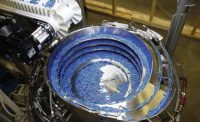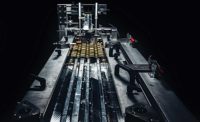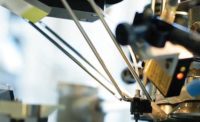Thermoelectric coolers are great for day trips, tailgating, boating or even overnight camping trips. Instead of ice, these coolers rely on a thin, flat electronic assembly called a Peltier device. When a DC electric current flows through the device, it transfers heat from one side to the other, so one side gets cooler while the other gets hotter. The hot side is attached to a heat sink, so that it remains at ambient temperature, while the cool side goes below room temperature.
In a thermoelectric cooler, Peltier devices can reduce the temperature by up to 36 F below the ambient temperature. Besides portable coolers, Peltier devices provide cooling for climate-controlled jackets, DNA analyzers, astronomical instruments, lasers and industrial electronics.
A Peltier device consists of an array of tiny, cube-shaped semiconducting materials, called P and N elements, sandwiched between two thin, conductive plates made from different metals. Assembling these devices is no small challenge.
One manufacturer of Peltier devices needed to supply a steady flow of P and N elements to its assembly line. Each element is made from a different alloy of bismuth tellurium. The P Element is 1.3 by 1.3 by 1.47 millimeters; the N Element is 1.1 by 1.1 by 1.47 millimeters. The manufacturer had to supply thousands of each cube to the line every 90 seconds, and the cubes had to be correctly aligned with a probability of more than 99 percent.
The SV-02 shaker table from Shaketron Technology Corp. solved the problem. Shaketron’s machines use vibrations to sort, position and align small parts. Bulk parts are placed in a metal tray. At the bottom of the tray is a removable, custom-made fixture with holes or pockets to accept the parts. The holes are designed to align the parts in the exact direction, orientation, pitch and quantity needed for the application.
When the machine is switched on, the parts vibrate in the tray and randomly fall into the holes. Only a part in the correct direction and orientation can slide into a hole. To ensure all the holes get filled, the table tilts back and forth to give loose parts a chance to find empty holes.
Parameters such as the amplitude of the vibrations and the rate, height and speed of the table tilt can be adjusted via a touch screen, and the settings for particular parts can be saved in memory.
When a fixture is full, it can be removed and placed in an assembly system, where a robot can pick and place the parts. While the shaker machine is populating a fixture, the operator can be doing another task, such as inspection or resupplying parts.
Shaker machines can apply vertical or horizontal vibrations. Vertical vibrations are best for pin-shaped or odd-shaped parts. Horizontal vibrations are best for flat or slender parts. One shaker machine can align many kinds of parts, simply by changing the fixture.
For the Peltier device application, Shaketron created a set of eight jigs to hold the P and N elements. Measuring 40 by 45 millimeters, each jig holds 153 P elements and 153 N elements. So, a full set of eight jigs supplies 2,448 parts.
For more information, call Shaketron at 847-337-1120 or visit www.shaketron.com.




